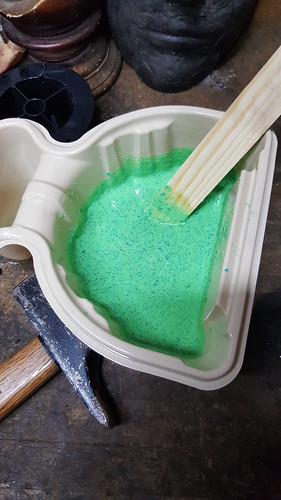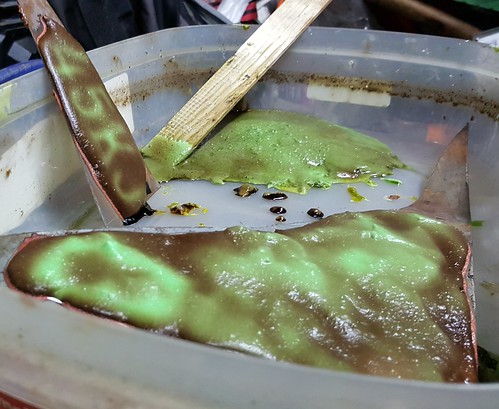Historical Etching Recipes
Moderator: Glen K
-
John Vernier
- Archive Member
- Posts: 232
- Joined: Mon Mar 14, 2011 5:57 pm
- Location: south central Indiana
Re: Historical Etching Recipes
The parts about recommending which wood to use to make charcoal-linden or willow, depending on the source- may just be about wanting to produce a pure, tar-free charcoal. Willow and linden are both relatively low-resin woods and would carbonize while producing a lot less pitch or tar than some other woods, especially pines or other coniferous woods.
Re: Historical Etching Recipes
That may well be the heart of it. Willow is (as I understand it) a favorite wood for the guys who make their own black powder. Perhaps using any of the woods recommended for powder would be a good starting point is one were to try experimenting with one of these recipes.John Vernier wrote:The parts about recommending which wood to use to make charcoal-linden or willow, depending on the source- may just be about wanting to produce a pure, tar-free charcoal. Willow and linden are both relatively low-resin woods and would carbonize while producing a lot less pitch or tar than some other woods, especially pines or other coniferous woods.
That does add another layer of difficulty though.... it would be a lot easier if we could just pulverize some of the "Cowboy Brand" charcoal that's readily available. That's certainly where I hoped I would could start.

Mac
Robert MacPherson
The craftsmen of old had their secrets, and those secrets died with them. We are not the better for that, and neither are they.
http://www.lightlink.com/armory/
http://www.billyandcharlie.com
https://www.facebook.com/BillyAndCharlie
The craftsmen of old had their secrets, and those secrets died with them. We are not the better for that, and neither are they.
http://www.lightlink.com/armory/
http://www.billyandcharlie.com
https://www.facebook.com/BillyAndCharlie
Re: Historical Etching Recipes
I've been worrying about the whole charcoal thing in these recipes. What do we think it's there for?
My thoughts run in two directions...
--perhaps the charcoal is there only to provide inert bulk to the reagents, and helps to make a paste of suitable consistency.
--perhaps the fibrous structure of the charcoal provides avenues for capillary flow of ions within the paste.
Thoughts? Ideas?
Mac
My thoughts run in two directions...
--perhaps the charcoal is there only to provide inert bulk to the reagents, and helps to make a paste of suitable consistency.
--perhaps the fibrous structure of the charcoal provides avenues for capillary flow of ions within the paste.
Thoughts? Ideas?
Mac
Robert MacPherson
The craftsmen of old had their secrets, and those secrets died with them. We are not the better for that, and neither are they.
http://www.lightlink.com/armory/
http://www.billyandcharlie.com
https://www.facebook.com/BillyAndCharlie
The craftsmen of old had their secrets, and those secrets died with them. We are not the better for that, and neither are they.
http://www.lightlink.com/armory/
http://www.billyandcharlie.com
https://www.facebook.com/BillyAndCharlie
- Chris Gilman
- Archive Member
- Posts: 2467
- Joined: Fri Oct 18, 2002 1:01 am
- Location: Sylmar CA.
- Contact:
Re: Historical Etching Recipes
Taking an archaeologist point of view,....It was used for religions beliefs.
Re: Historical Etching Recipes
Chris Gilman wrote:Taking an archaeologist point of view,....It was used for religions beliefs.
There is more truth here than there should be...
-
James Arlen Gillaspie
- Archive Member
- Posts: 2098
- Joined: Mon Jan 13, 2003 2:01 am
- Location: NY
- Contact:
Re: Historical Etching Recipes
I run into many such tool-like 'ritual objects' at swap meets.
-
coreythompsonhm
- Archive Member
- Posts: 2689
- Joined: Wed Apr 20, 2011 3:28 am
- Location: Federal Way/Seattle, Washington
Re: Historical Etching Recipes
Ugo and I tried out using the salt, copper sulphate, and vinegar paste. The first batch we accidently added a little too much vinegar, making the paste a little on the runny side. We also just used the CS and salt as is out of the containers. The results were a pocked background, notable where large CS crystals were embedded in the copper toned crust.
Deciding that the CS and Salt needed to be finer, we purchased a coffee grinder to grind up the ingrediants. We ground the CS and salt to a flour like consistency. I carefully added very tiny amounts of vinegar into the mixed powder, until it performs like a colloid hydrogel. It makes this stuff a wonder to work with on non horizontal surfaces. Still need to test on inverted. The second test batch we coated one horizontal surface and one verticle surface.
The results were satisfactory. Etched surface was a better quality than nitric or sulferic acid. Etch depths were consistent throughout the test piece, unlike objects submerged in acid.
I will upload images once Christmas plans are over with.
Deciding that the CS and Salt needed to be finer, we purchased a coffee grinder to grind up the ingrediants. We ground the CS and salt to a flour like consistency. I carefully added very tiny amounts of vinegar into the mixed powder, until it performs like a colloid hydrogel. It makes this stuff a wonder to work with on non horizontal surfaces. Still need to test on inverted. The second test batch we coated one horizontal surface and one verticle surface.
The results were satisfactory. Etched surface was a better quality than nitric or sulferic acid. Etch depths were consistent throughout the test piece, unlike objects submerged in acid.
I will upload images once Christmas plans are over with.
-
Baron Alcyoneus
- Archive Member
- Posts: 39578
- Joined: Tue Sep 23, 2008 7:00 pm
Re: Historical Etching Recipes
So, which of the various recipes would you recommend using?
Vypadni z mého trávnÃk!
Does loyalty trump truth?
"If they hurt you, hurt them back. If they kill you, walk it off."- Captain America
Does loyalty trump truth?
"If they hurt you, hurt them back. If they kill you, walk it off."- Captain America
-
coreythompsonhm
- Archive Member
- Posts: 2689
- Joined: Wed Apr 20, 2011 3:28 am
- Location: Federal Way/Seattle, Washington
Re: Historical Etching Recipes
I would say what John Tavares came up with through his research. Chris Gilman has also been using the same recipe to great effect. I part salt, 2 parts copper sulphate, approximately 1/3 part vinegar. Add vinegar in slowly and sparingly. 1 mixed it in where it was on the side of not enough, let it sit for an hour for the crystals to dissolve.
edited for pics:
first try. Notice the large crystals still undissolved. Background is pitted like crazy.
 20171217_181150 by coreythompsonhm, on Flickr
20171217_181150 by coreythompsonhm, on Flickr
 20171218_105137 by coreythompsonhm, on Flickr
20171218_105137 by coreythompsonhm, on Flickr
Second try. Salt and Copper sulfate ground up into a fine powder, then mixed with vinegar. A finer background is present. Used random vinyls we had laying around for a resist.
 20171219_103754 by coreythompsonhm, on Flickr
20171219_103754 by coreythompsonhm, on Flickr
As you can see, when mixed to the right consistency, once the paste settles from liquid to "hard" (about a few minutes), the paste stayed in this nearly veritcal position for approximately a ten hour etch.
 20171219_114121 by coreythompsonhm, on Flickr
20171219_114121 by coreythompsonhm, on Flickr
edited for pics:
first try. Notice the large crystals still undissolved. Background is pitted like crazy.
 20171217_181150 by coreythompsonhm, on Flickr
20171217_181150 by coreythompsonhm, on Flickr 20171218_105137 by coreythompsonhm, on Flickr
20171218_105137 by coreythompsonhm, on FlickrSecond try. Salt and Copper sulfate ground up into a fine powder, then mixed with vinegar. A finer background is present. Used random vinyls we had laying around for a resist.
 20171219_103754 by coreythompsonhm, on Flickr
20171219_103754 by coreythompsonhm, on FlickrAs you can see, when mixed to the right consistency, once the paste settles from liquid to "hard" (about a few minutes), the paste stayed in this nearly veritcal position for approximately a ten hour etch.
 20171219_114121 by coreythompsonhm, on Flickr
20171219_114121 by coreythompsonhm, on Flickr